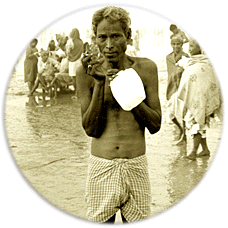Photo Project Proposal
In January of 2001 an estimated twenty million pilgrims will travel to Prayag, the confluence of the Yamuna, the Ganga and the mythical Saraswati rivers in Allahabhad, to bathe during this centuries first Kumbh Mela. The Kumbh Mela is the greatest singular gathering in the Hindu religious tradition, and constitutes one of the world's largest pilgrimages. The mela (fair) presents a "kaleidoscopic view" of India drawing pilgrims from every corner of the subcontinent as well as from abroad.
The Kumbh Mela is a religious festival of great antiquity that celebrates central events in Indian mythology. It is believed that one time the gods and demons of the world joined forces to churn the ocean to obtain its treasures, the most valuable of which was a kumbh (pot) containing the nectar of immortality. As Dhanwantari, the divine healer, appeared on the surface of the ocean carrying the pot of nectar it was spirited away by the gods. A large battle erupted as the demons chased the god carrying the pot of nectar across the sky. In the 12 day battle the ensued four drops of the precious liquid fell in four locations: Prayag, Hardwar, Nasik and Ujain. Since then these four cities have been worshipped as sacred and have celebrated Kumbh Mela festivals every 12 years.
The scale and grandeur of the Kumbh Mela is beyond measure. A temporary city stretching for 130 square kilometers will be constructed to house the devout. Within this landscape hundreds of tiny shrines, makeshift temples and ashrams of saints will be found. In the early morning and late evenings pilgrims will be found listening to the recitation of holy texts, participating in the chanting of hymns, and taking darshan (to see) of holy men and reclusive ascetics. At the fairs climax millions of pilgrims will follow processions of naga sadhus (naked holy men) to bathe in the river and present offerings of flowers.
My goals in attending the Prayag Maha Kumbh Mela is to be present at the central snanayogas (auspicious bathing dates) and to document the grand processions and the bathing rituals as well as the activities that occur on the periphery of these central events. Pilgrims from across India will be present and each group will observe unique customs and religious practices, wear their own styles of clothing, construct their own distinct temporary alters, and, in essence, participate within the Kumbh Mela in unique and personal ways. It is my goal to capture the beauty and complexity of these many approaches to celebrating a unique and distinctly Indian event.
